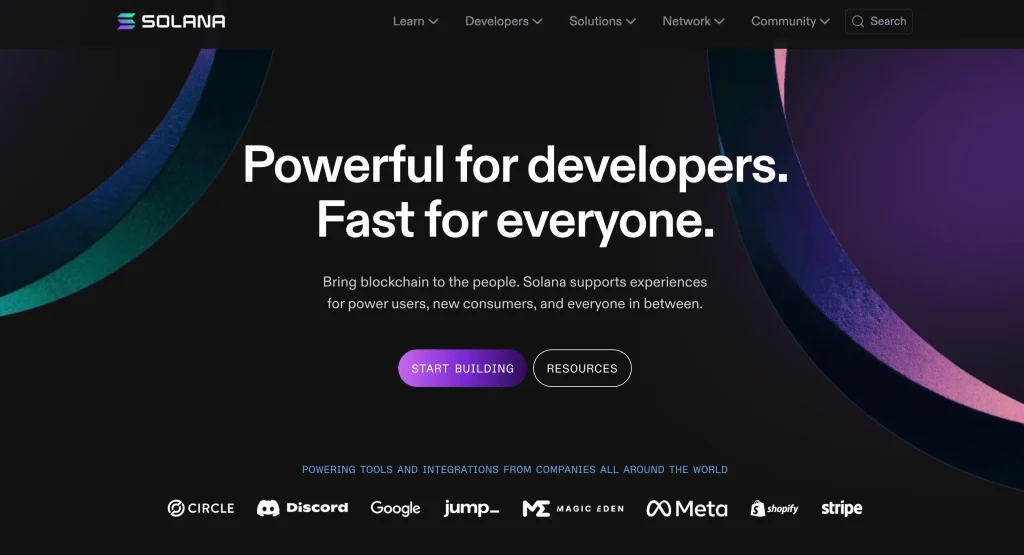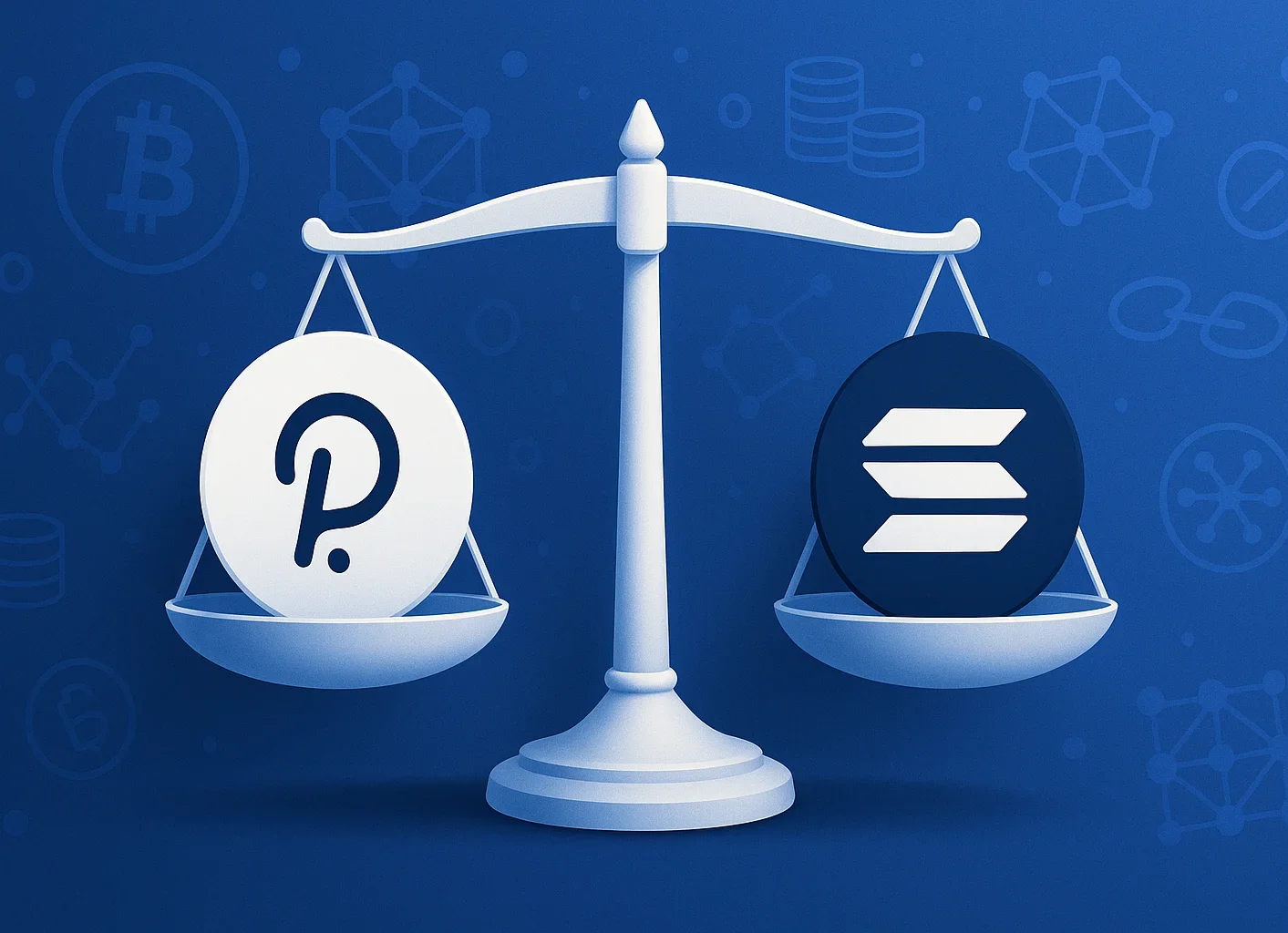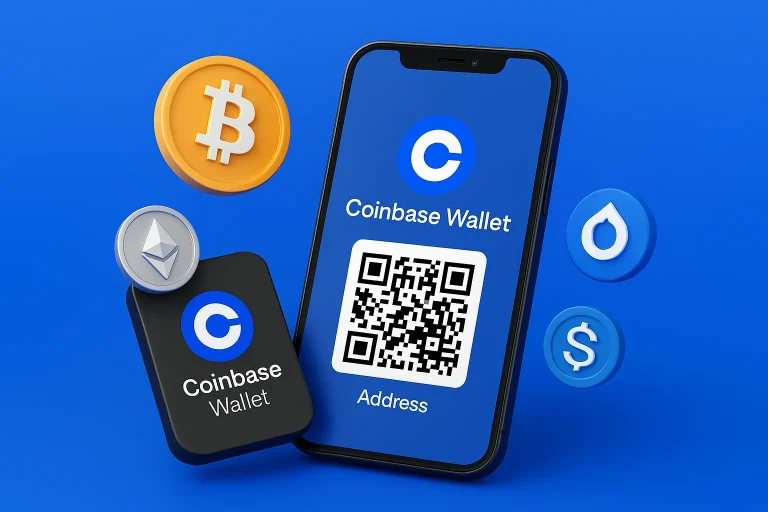The cryptocurrency space is rushing, making it more challenging to choose the right platform. You want speed, network security, scalability, and strong community support, but which one delivers? The big question is: Polkadot vs Solana?
Both blockchains have their strengths and serve different needs. Whether you’re a blockchain developer, investor, or everyday user, your choice depends on what matters most for you.
This guide delves into these two leading blockchain networks, covering everything from performance and security to investment potential and real-world applications. By the end, you’ll be ready to choose the blockchain that best suits your goals.
Table of contents
Quick Snapshot: Solana vs Polkadot |
|
|---|---|
| Polkadot | Speed: Moderate, scalable via parachains; Fees: Competitive and variable; Interoperability: Native, built-in cross-chain support; Developer Experience: Substrate framework, ink!, Solang; Security: Shared security via Relay Chain; Governance: Fully on-chain, decentralized; Real-World Focus: Interoperable Web3, enterprise chains. |
| Solana | Speed: Extremely fast (up to 65,000 TPS); Fees: Ultra-low (fractions of a cent); Interoperability: Limited, relies on external bridges; Developer Experience: Rust & C, developer-friendly SDKs; Security: PoH + PoS, concerns over centralization; Governance: Off-chain, evolving toward decentralization; Real-World Focus: High-throughput dApps, DeFi, NFTs, and gaming. |
Polkadot: The Interoperability Pioneer

Polkadot network is a next-generation blockchain technology protocol that connects multiple blockchains into a single, unified decentralized network.
Unlike monolithic blockchains, Polkadot aims to create a “blockchain of blockchains,” fostering an environment where different blockchain networks can operate independently yet securely and efficiently interact.
Specifications |
|
|---|---|
| Cross-chain Communication (XCM) | Enables seamless transfer of any data or asset between parachains and other networks. |
| Shared Security Model | The Polkadot Relay Chain’s security benefits all parachains connected to it, reducing the burden on individual chain developers. |
| Substrate Framework | A modular framework enabling developers to easily build custom blockchains (parachains) tailored to specific use cases. |
Consensus Mechanism: Nominated Proof of Stake (NPoS)
Polkadot uses a unique consensus algorithm called Nominated Proof of Stake to secure its network. Here’s how it works:
- Validators are responsible for producing new blocks and validating transactions.
- Nominators are DOT token holders who support trustworthy validators by staking their tokens in favor of them.
- This system incentivizes good behavior and decentralization by allowing the community to select who secures the network.
- NPoS is designed to be energy-efficient (unlike Proof of Work), while maintaining strong network security and fast transaction finality.
- It ensures that the validator set is fairly distributed and no single entity can dominate the network.
Solana: The High-Speed Blockchain

Solana network is a high-performance blockchain platform built on innovative blockchain technology for speed, scalability, and low-cost transactions. It aims to provide a robust network infrastructure for decentralized applications (dApps) and crypto projects that require high throughput and minimal fees.
Due to its efficiency and developer support, the Solana blockchain is often positioned as an “Ethereum killer.”
Specifications |
|
|---|---|
| High Throughput Architecture | Thanks to its unique design, Solana can handle tens of thousands of transactions per second (TPS), making it one of the fastest blockchains available today. |
| Developer-Friendly Tools | Solana supports popular programming languages like Rust and C, making it accessible and appealing to many developers building scalable dApps. |
| Low-Cost Transactions | The network is designed to keep transaction fees extremely low, making it ideal for high-volume use cases such as DeFi, NFTs, and gaming applications. |
Consensus Mechanism: Proof of History (PoH) + Proof of Stake (PoS)
Solana combines two consensus innovations to optimize performance:
- Proof of History (PoH): A cryptographic clock that records a verifiable timeline of events, dramatically improving transaction ordering and block finality.
- Proof of Stake (PoS): Works alongside PoH to secure the network by allowing validators to stake tokens and participate in consensus.
This hybrid model enables high-speed processing without compromising security or decentralization.
1. Performance Comparison: Speed, Fees, and Scalability
Both networks aim for high performance, but their approaches yield different results.
Transaction Speed (TPS)
Solana: Boasts significantly higher theoretical and often real-world transaction speeds, aiming for up to 65,000 TPS.
Polkadot: While individual parachains may have varying speeds, the Polkadot ecosystem’s overall throughput is designed to scale horizontally by adding more parachains. Yet, single-chain TPS is generally lower than Solana’s.
Transaction Fees
Solana: Known for its ultra-low transaction fees, often fractions of a cent.
Polkadot: Fees can vary by parachain, but generally remain competitive and are designed to be efficient within its shared security model.
Scalability & Network Throughput
Solana: Achieves high scalability through its monolithic architecture and PoH, which optimizes transaction processing.
Polkadot: Scales via its sharded architecture (parachains), allowing parallel processing of transactions across multiple chains, addressing scalability through parallelization rather than a single, ultra-fast chain.
2. Interoperability and Ecosystem
Polkadot’s Interoperability Advantage
Polkadot’s core design revolves around interoperability. Its Relay Chain facilitates seamless, trustless communication and asset transfer between its parachains and potentially external blockchain networks via bridges.
This creates a highly connected and flexible crypto ecosystem where specialized blockchains can work together. Polkadot operates as the backbone of many collaborative Web3 solutions.
Solana’s Ecosystem Growth
While not built primarily for cross-chain interoperability like Polkadot, Solana has seen rapid growth in its ecosystem, particularly in DeFi, NFTs, and gaming.
Solana focuses on providing a high-performance environment for applications that thrive on speed and low latency.
Developer Experience
Polkadot
Developers can build custom blockchains with the Substrate framework, which offers immense flexibility. Smart contract development often uses ink! (Rust-based) or Solang (a Solidity compiler for Polkadot).
Solana
It primarily supports Rust for smart contract development, offering a streamlined experience for those familiar with the language. It also provides developer-friendly tools and SDKs for building high-throughput applications.
3. Investment Analysis
1. DOT (Polkadot) Token Economics
Variable supply: The total number of DOT tokens is not fixed. It can increase over time through inflation, which means new DOT tokens are created regularly.
Inflation mechanism: Inflation encourages people to stake their DOT tokens (lock them up to help secure the network). When you stake DOT, you earn rewards paid in new tokens. This system motivates more users to participate in securing the network.
Why inflation helps: By rewarding stakers with new tokens, Polkadot keeps the network safe and decentralised. If you hold and stake DOT, you get extra DOT as a reward, which helps balance inflation over time.
Token Utility
- Staking: Stake DOT to help secure the network and earn rewards.
- Governance: DOT holders can vote on important decisions, like upgrades or rule changes.
- Parachain Auctions: Projects bid DOT tokens in auctions to get a slot on Polkadot’s network (parachain).
2. SOL (Solana) Token Economics
Fixed Maximum Supply: Solana caps the total number of SOL tokens that will exist. This means there is a limit to how many tokens can be circulated.
Burning Mechanism: Every time a transaction happens on the Solana network, a small amount of SOL is “burned,” meaning those tokens are permanently destroyed. Burning reduces the total supply over time, which can help increase the value of SOL by making tokens scarcer.
Inflation Schedule: Even with a fixed max supply, Solana initially has inflation to reward those who stake SOL tokens to secure the network. Over time, the inflation rate decreases according to a set schedule.
Token Utility
- Transaction Fees: SOL is used to pay for running transactions and smart contracts.
- Staking: Users can stake SOL to support network security and earn staking rewards.
- Governance: SOL holders can participate in network governance, although governance is still evolving on Solana.
DOT vs. SOL: Utility and inflation models
| Aspect | DOT (Polkadot) | SOL (Solana) |
| Total Supply | Variable increases with inflation. | Fixed maximum supply. |
| Inflation Purpose | Incentivize staking & network security. | Reward staking, inflation decreases over time. |
| Deflation Aspect | None specific. | The burning mechanism reduces the supply. |
| Main Uses | Staking, governance, and parachain auctions. | Transaction fees, staking, governance. |
| Investor Impact | Inflation can dilute value if not staked, but staking rewards offset this. | Burning may reduce supply and increase value, but inflation may offset some gains initially. |
Key Investment Considerations
1. Risk profile
DOT: Due to its parachain model, DOT faces risks related to technical complexity, ecosystem adoption, and regulatory uncertainty.
SOL: Exposed to network outages, centralization concerns, and execution risks tied to rapid development.
2. Volatility
DOT: Moderate volatility, influenced by ecosystem growth and parachain activity.
SOL: Higher volatility, reacting strongly to technical achievements and disruptions.
3. Growth potential
DOT: Strong in interoperability, developer tools, and long-term infrastructure value. Growth depends on parachain success.
SOL: Excels in speed and low fees, driving adoption in DeFi, NFTs, and Web3 apps. Backed by active VC funding and a vibrant community.
4. Security and Decentralization
Security Models
Polkadot uses a shared security model, where all parachains benefit from the security of the central Relay Chain. This approach offers a strong level of collective protection for the entire network.
Solana relies on its innovative combination of Proof of History (PoH) and Proof of Stake (PoS) to deliver fast and secure transactions. Yet, its high hardware requirements for validators and past network outages have raised concerns about potential centralization risks.
Network Stability
Polkadot is built for high stability through its robust multi-chain architecture, ensuring consistent performance and scalability.
Solana, known for its speed, has experienced many network outages. These incidents have raised concerns about its reliability, though the development team continues to improve network resilience.
Governance Comparison
Polkadot offers a highly decentralized, on-chain governance system. Holders of the DOT token can directly vote on upgrades and decisions, promoting active community involvement.
Solana currently uses an off-chain governance model, but ongoing efforts are focused on increasing community participation and moving toward greater decentralization.
5. Use Cases and Real-World Applications
Real-World Use Cases of Polkadot
Polkadot is ideal for projects requiring:
- Cross-chain DeFi: Enabling complex financial applications across many blockchains.
- Web3 Infrastructure: Building interconnected dApps that leverage specialized chains.
- Enterprise Solutions: Custom blockchains for specific business needs that require interoperability.
Real-World Use Cases of Solana
Solana excels in applications demanding high throughput and low latency:
- NFT Marketplaces: Facilitating fast and cheap minting and trading of NFTs.
- Decentralized Exchanges (DEXs): Offering near-instantaneous trades with minimal fees.
- Gaming: Supporting fast-paced blockchain games and in-game economies.
Target Markets and Industries
Polkadot: Targets a broad range of industries that can benefit from customized, interconnected blockchains, focusing on the broader Web3 vision.
Solana: Aims for high-volume, real-time applications where speed and cost-efficiency are paramount.
FAQ
What Is the Best Swap for Solana?
The best swap for Solana is Serum, a decentralized exchange built on Solana’s fast blockchain. It offers low fees, high speed, and deep liquidity, making it ideal for swapping SPL tokens.
Is Polkadot Worth Keeping?
Polkadot is worth keeping due to its innovative multi-chain network, strong developer community, and growing ecosystem. Its focus on interoperability and scalability makes it a promising long-term investment.
Can I Bridge Assets Between Solana and Polkadot?
You can bridge assets between Solana and Polkadot using specialized cross-chain bridges like Wormhole. These bridges enable seamless asset transfers and communication between the two blockchains.
Which Blockchain Is Better for Launching an NFT Project?
Solana is generally better for launching NFT projects thanks to its low transaction fees and fast processing times. Yet, Polkadot offers unique interoperability features that can benefit complex NFT ecosystems.
What Are the Main Risks of Each Platform?
Solana risks include network outages and centralization concerns, while Polkadot faces challenges related to cross-chain security and complexity. Both platforms require careful evaluation before committing assets.
Final Verdict: Polkadot or Solana?
Picking between Polkadot vs Solana isn’t about naming a single “winner.” Instead, it’s about understanding which platform matches your needs and goals.
Winner by category
- Speed: Solana takes the lead with its high transaction throughput.
- Interoperability: Polkadot shines by design, enabling seamless cross-chain communication.
- Fees: Solana generally offers lower fees, especially for high-volume transactions.
- Ecosystem Maturity: It’s a tie, both have vibrant, growing ecosystems with different strengths.
- Investment Potential: Depends on your goals. Polkadot is great for long-term infrastructure investment, while Solana targets high-growth, high-speed applications.
Which should you choose?
For Developers:
- Choose Polkadot if your project needs custom blockchain logic, cross-chain communication, or shared security.
- Choose Solana if you want extreme transaction speed, low fees, and a simpler Rust-based development environment.
For Investors:
- Polkadot appeals to those interested in a foundational interoperability layer with a long-term Web3 vision.
- Solana attracts investors aiming for growth in high-performance sectors like DeFi and gaming. Your decision depends on your risk tolerance and investment timeline.
For Users:
- Solana is usually preferred for quick, cheap transactions (such as trading NFTs or high-frequency DeFi apps).
- If you’re going to interact with various specialized apps across different chains, Polkadot offers unique advantages.
Polkadot and Solana serve different niches in the blockchain space. They complement each other rather than directly compete. Many users and investors find value in engaging with both, making them solid options for diversifying a crypto portfolio.




